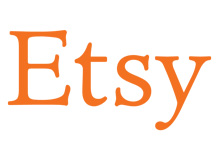A hand-embroidered cocktail dress with a flouncy tulle skirt the color of a pink Necco wafer for $64; a 1967 auto repair manual with authentic grease smudges and coffee stains for $28; a spoon rest fashioned out of a melted and flattened Rolling Rock beer bottle for $12; and a 16-inch ottoman with a washable slipcover made to look like butter cream frosting for $169. These are some of the weird and wonderful wares for sale recently on Etsy, the online marketplace for handmade and vintage items.
Founded in 2005, Etsy started as a ragtag website for artists and craftspeople to sell their wares. Today, it has evolved into a funky online bazaar with more than 800,000 “stores” selling 13 million different items. It is also a surprisingly big business: According to recent figures, the site gets more than 39 million unique visitors every month, and last year rung in sales of $525.6 million.
Its influence as a tastemaker is growing: A study earlier this year by RJ Metrics, the business intelligence company, found that Etsy is the most “pinned” site on Pinterest, the popular social network. Some perspective: Martha Stewart is the sixth most pinned website, Amazon is the 14th most pinned site, and Anthropologie, the boho-chic clothing shop, is the 16th most pinned site.
“Etsy is kind of like a very well run, high-quality street fair,” says Barbara Kahn, a Wharton marketing professor, adding that in the era of monotonous chain stores and cookie-cutter strip malls, Etsy’s allure lies in its inventory of unique items. “You find things that are new and novel — things that you wouldn’t see in a department store. The attraction for shoppers is the serendipity of finding exactly what you want after combing through the possibilities.”
While online shopping kismet is appealing for some, it is also one of the biggest hindrances to Etsy’s continued success, she notes. The site is so vast that for the uninitiated, Etsy can seem less like an eclectic online boutique and more like a jumbled tag sale. Given its meteoric growth, Etsy needs to come up with new ways to help customers find exactly what they’re looking for, all the while ensuring that sellers are visible and not lost in the shuffle, experts note. As the company mulls a public offering, it also must be careful not to alienate its faithful shop owners and customers by going too commercial and straying from its independent, artsy roots, or by becoming bogged down in privacy and credibility concerns.
Delighting Customers
The story of Etsy begins with its founder, Rob Kalin, a high school dropout with a classics degree from New York University. As company lore has it, seven years ago, Kalin — then a 25-year-old amateur carpenter and photographer living in a cramped Brooklyn apartment — was trying to eke out a living hawking his handiwork online. After having difficulty finding the right Internet outlet, he came up with an idea: Create a marketplace on the web for artists and craftspeople to sell their work directly to customers. With $50,000 of seed money from an angel investor and the help of some technically minded friends, he launched Etsy. In its first year in business, the company’s sales totaled $175,000.
Today, Etsy remains headquartered in Brooklyn, N.Y. Last year, Kalin stepped down as Etsy’s chief executive, which many observers said was a sign that top leadership recognized that Kalin was not the best person to manage the needs of a rapidly scaling business enterprise. (Chad Dickerson, the company’s former chief technology officer, has taken over.) The company gets 1.4 billion monthly page views and does business in 150 countries. Its sales last year increased 67% over sales in 2010. (Etsy charges its virtual shopkeepers a listing fee of 20 cents an item and takes a transaction fee of 3.5% of the item price for every sale.)
“Now that Etsy is successful, clearly its biggest asset is that it is big,” says Gregg Fairbrothers, professor of business administration at Dartmouth’s Tuck School of Business and director of the Dartmouth Entrepreneurial Network. “If you are an artist and you want to be seen by a lot of people, you sell on Etsy. If you are a customer looking for crafts, you shop on Etsy.” As an e-commerce company, Etsy cultivates a self-consciously offbeat and eccentric vibe. Its tone is high-minded: Etsy’s mission statement, for instance, says that the company aims to bring “heart to commerce” and make the world “more fair, more sustainable, and more fun.”
The company is most definitely geared toward female customers. (Of the respondents to Etsy’s 2010 survey of its blog readership, 97% were women.) Even those run the gamut, however. Its eye-catching color-coordinated homepage seems like it is trying to appeal to young urban hipsters who read online shelter magazines. But Etsy also has a sizeable inventory of homey products such as needlepoint pillows of sleeping cats and crocheted toilet paper covers.
“What’s striking is that Etsy’s growth has been organic from word of mouth,” notes Leonard Lodish, professor of marketing at Wharton. “Etsy delights its customers so they tell their friends, and they become enthusiastic proselytizers. That’s the secret.” Etsy’s success is due to the convergence of two big trends, one technological and the other cultural. On the technology side, experts say that Etsy has benefitted from a number of advancements that have fueled an online boom in entrepreneurship. Socially speaking, Etsy’s offerings fulfill deep desires on the part of shoppers seeking one-of-a-kind, handmade goods that speak to their own personal aesthetic.
Ubiquitous access to the Internet has made it easier for micro-manufacturing and person-to-person commerce to take place, according to Bryan Pearce, Americas director of Ernst & Young’s Entrepreneur Of The Year program. “The explosion in mobile and tablet computers means that we can shop and browse even when we’re just killing time,” he says.
The ability to capture high-quality images and pictures is another factor contributing to Etsy’s growth. Etsy merchants are able to design their virtual storefronts with sleek and stylized photographs and designs. “It’s easy to take a high-resolution picture with your tablet, mobile phone or digital camera. It looks professional, and it has leveled the playing field [for stores like Etsy] with catalogs and traditional retailers,” Pearce notes.
Pearce also cites the increase in simple online payment systems, which make it affordable to do transactions. The increased number of outlets that enable easy shipping and logistical assistance have also accelerated growth. “Even the post office has one size/one price options that make everything easier,” he says.
Another factor driving Etsy’s success is the economy, adds Pearce. While hardly any of the company’s merchants can claim their Etsy shops as a full-time job, the site offers tinkerers and hobbyists — some of whom may be stay-at-home parents or even those already employed full time — the opportunity to earn a little extra income. “They are converting a hobby into a source of cash flow,” he says. “These types of businesses do not require a lot of capital. It’s not like going out and building a semiconductor company. Today, there are so many resources for people to learn about getting into business, [that they] are much more willing to give it a try.”
Etsy offers all the traditional retailing categories — furniture, homewares, clothing and paper goods — as well as some unusual categories such as dolls and miniatures. The site also has a category called Geekery, which features playful items such as dangly earrings made out of Lego pieces, hand soap shaped like a croissant that smells of warm baked bread, and silver-studded iPhone cases.
Items like these appeal to shoppers who are looking for uniqueness rather than sameness, notes Ian Cross, senior lecturer in marketing at McCallum Graduate School of Business at Bentley University in Waltham, Mass. “People are bored with the mall. They are unimpressed with the same stores selling the same stuff…. There’s very little exciting in the stores today, so consumers are looking to the web for reasonably-priced alternatives. No one wants to shop at Gap anymore.”
Indeed, mainstream retailers are increasingly looking to private labels and exclusive lines in order to differentiate themselves in a crowded market. Faced with increased competition from Etsy and other e-retailers, some department stores and big box chains are searching for ways to retool store design and product mix, and to improve the multi-channel customer service experience.
Cross adds that Etsy also plays to consumers’ romantic notion of shopping in ways that are supporting local artisans. Shoppers on Etsy are able to “buy nearby” and find sellers close to them. “Etsy is popular for the same reasons that you buy fresh fish caught [near to where you live] at Whole Foods. You feel good supporting the local economy.”
Leah Russell, an Etsy storeowner based out of Largo, Fla., who sells mod children’s clothing, says she was inspired to start sewing after her daughter was born and she couldn’t find dresses that weren’t “ruffled or floral…. I’m a big believer in the handmade market,” she notes. “When you go to a big box store and buy a girl’s dress for $15, that dress was probably mass-produced in a factory in China. And you’re going to see 15 or 20 other little kids in that exact same dress.”
Too Much of a Good Thing?
Etsy is already a successful company, but it has had its fair share of growing pains, including a number of privacy hiccups. For example, last March, after the company instituted some changes to make the site function more like a social network, some buyers found that their activity on Etsy — including their purchase histories and, in some cases, their real names — was publicly available. In reaction to the outcry, Etsy further changed its system so such personal details would remain private.
But the site has also come under fire by some in the seller community for allowing vendors — who may not be as small and unique as they claim — to sell on Etsy. Recently, some users criticized the site for highlighting a “featured seller” on its blog who appeared to be in violation of some of Etsy’s policies because it was unclear if the seller was actually making all of her wares herself.
But Etsy’s largest stumbling block for future growth may be its overwhelmingly wide variety of products. It is one of the reasons many shoppers keep coming back, but it turns others away, says Wharton’s Kahn, who has conducted research on the effect of product placement and promotion in physical stores. She notes that a simple search on blue purses, for instance, comes back with more than 45,000 items. “To some people that’s a good thing, but to many that’s extreme. If you’re very sophisticated and know exactly what you want, you can probably find it, but overall the site is not very well structured,” she says. “You can refine your search based on relevance and price, but those are pretty crude.”
The bigger issue, adds Kahn, is that in the age of Facebook and Pinterest, where social media users are accustomed to a more guided online experience, shopping on Etsy is cumbersome and chaotic. “All the artisans hold their own inventory; Etsy is just putting it out there,” she states. “Etsy is not doing a good job at curating, and at creating the story around the item. It has featured sellers, but beyond that, it’s hard to parse through.”
Etsy has several possible paths forward. The company has raised many rounds of venture funding — including a $20 million installment in 2010 — and it is said to be mulling a potential public offering within the next couple of years. It could also be snapped up by a bigger company. Given Etsy’s distaste of the mainstream marketplace, however, these options run the risk of alienating both customers and shopkeepers. Etsy’s stated mission is to “empower people to change the way the global economy works.” To Etsy’s tight-knit community of shop owners and customers, a Wall Street IPO or a sale to a big shopping or media conglomerate would be anathema.
There is always the concern that once a company is bought or goes public, it will lose a lot of “what made it so appealing in the first place,” according to David Bell, professor of marketing at Wharton and an expert in e-commerce. “This is particularly true of an e-commerce site like Etsy that has a segment of its existing client base that is anti-corporate.”
Facebook’s recent acquisition of Instagram, the quirky picture-sharing app, for $1 billion is a case in point. To a certain segment of Instagram users, Facebook — which made $4.27 billion in revenue last year, according to research firm Emarketer — was viewed under a cloud of suspicion. The company’s purchase of Instagram, which is not small (it has more than 30 million users) but perhaps felt that way to its faithful, incited a hostile response. “Already there’s been a backlash with some customers quitting the service,” notes Bell. “Loyal customers are worried that it’s going to go too corporate.”
Even if Etsy remains an independent company, future growth is contingent on the site staying true to its roots. Bonanza, an e-commerce company founded in 2007, was an early rival to Etsy and eBay. It started as a craft-focused site, but now sells a lot of mass-produced items. Compared with Etsy’s sleekly designed homepage, Bonana’s homepage resembles generic circular ads for middle-market clothing chains.
Staying true to its roots should not be difficult, says Wharton’s Lodish. Etsy is a powerful juggernaut in the crafts world, which is enough to scare off potential competitors. “There is a big barrier of entry,” he notes. “For another website to come along and try to convince millions of customers to look at it [as opposed to Etsy] for handcrafted stuff, is going to cost a lot of money.
“As long as Etsy is doing well by its artists and continues to delight its customers, why would anybody leave?”



